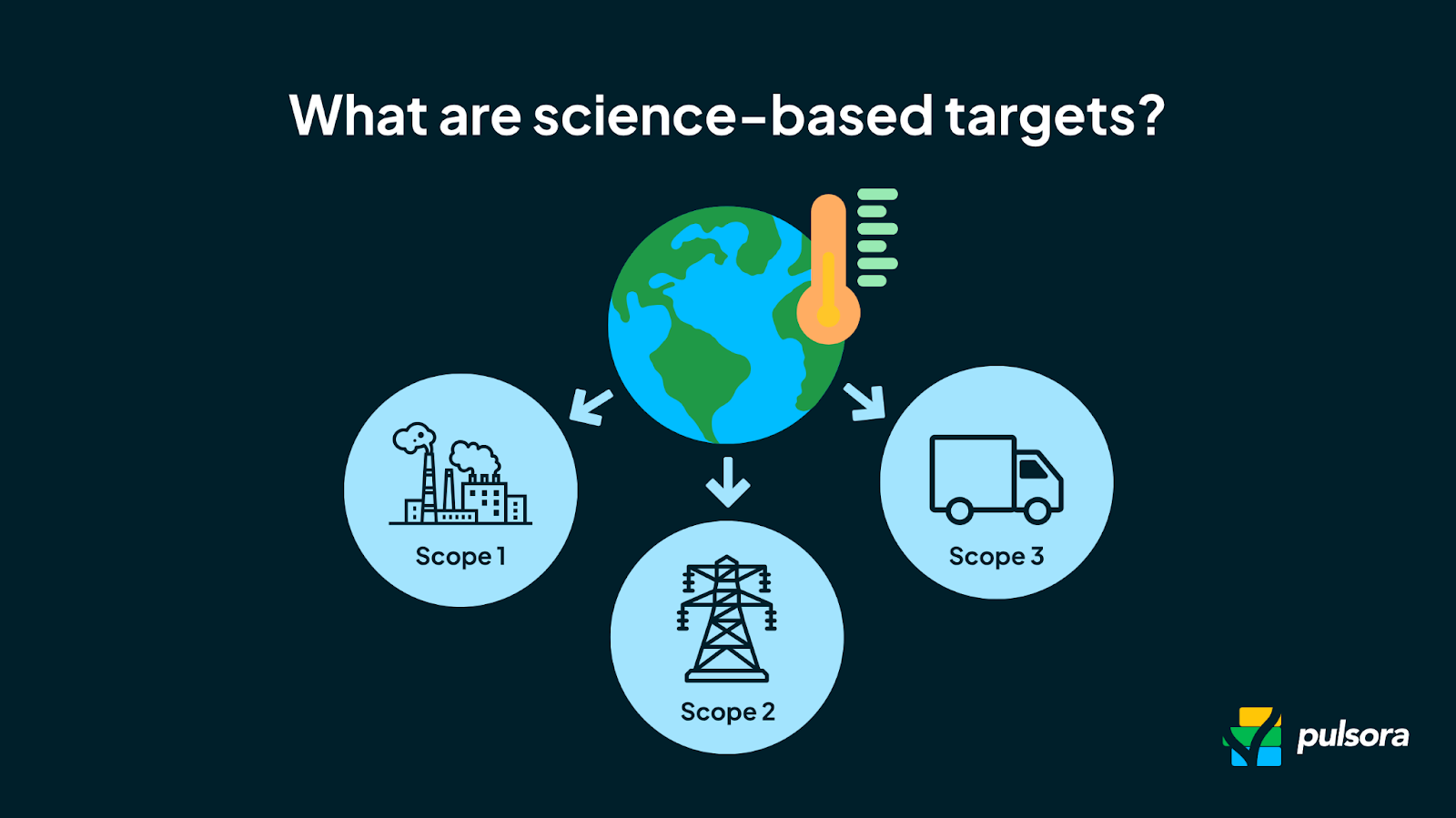TL;DR: Science-based targets (SBTs) help companies align their emissions reductions with climate science and the 1.5°C goal of the Paris Agreement. Governed by the Science Based Targets initiative (SBTi), these targets provide a credible framework for climate action across Scopes 1, 2, and 3. In this article, we explore what science-based targets are, how the SBTi works, and why setting SBTs is a strategic move for today’s climate-conscious enterprises.
Science-based targets, or SBTs, are some of the most trusted frameworks for businesses and financial institutions hoping to hit their emissions reduction targets aligned with climate science.
These targets are developed and validated through the Science Based Targets initiative, or SBTi), and they not only support global decarbonization goals but also unlock meaningful business value, like cost savings and investor confidence. More importantly, they support efforts to combat climate change.
Learn what the SBTi is as we break down the foundational concepts of science-based target setting and sector-specific guidance.
What are science-based targets?
Science-based targets are emissions reduction goals for greenhouse gas emissions (GHG) that align with what the latest climate science deems necessary.
Their goal is to offer mitigation strategies for global warming to 1.5°C above pre-industrial levels, as outlined in the Paris Agreement.
Unlike arbitrary net-zero emissions goals, SBTs are grounded in climate science, using methodologies developed by the Science Based Targets initiative (SBTi) to set reductions across Scope 1, 2, and 3 emissions.
- Scope 1 emissions: Direct emissions from owned or controlled sources
- Scope 2 emissions: Indirect emissions from purchased electricity, heat, or steam
- Scope 3 emissions: All other indirect emissions across a company’s value chain (e.g., suppliers, business travel, logistics)
By adopting science-based net-zero targets, companies will know their climate strategy is not just aspirational but actionable and measurable for a sustainable future.
💡 For more context on what science-based targets are and what they look like, check out sciencebasedtargets.org

What is the Science Based Targets initiative (SBTi)?
The Science Based Targets initiative is the organization behind the SBT framework. It’s a collaboration between:
- CDP
- United Nations Global Compact
- World Resources Institute (WRI)
- World Wide Fund for Nature (WWF)
Together, they define best practices for GHG emissions reductions and provide validation services to companies looking to set near-term targets and long-term net-zero goals.
Today, more than 10,000 companies globally have committed to or are in the process of validating their carbon emissions targets through the SBTi and furthering the mission behind the net-zero economy — a signal of growing momentum and credibility behind science-aligned climate action.
The SBTi criteria is widely recognized as the global gold standard for corporate net-zero standard and target submissions, with over 10,000 SMEs and larger enterprises committed or in the process of setting validated targets.
💡 SBTi 2.0 is here: Read everything you need to know about the new SBTi Corporate Net-Zero Standard.
What is the difference between SBTi Services and the Science Based Targets initiative?
The distinction is subtle but important:
- The SBTi (and founding partners like the We Mean Business Coalition) is the non-profit body that sets the standards and methodologies for science-based targets.
- SBTi Services is the operational arm responsible for validating submitted targets and providing technical review through offerings like the Target Validation Service, Net-Zero Standard Review, and related assessments.
Both work in tandem to ensure climate crisis commitments are robust and verifiable.
Are the SBTi and the SBTN the same?
No. Though they sound similar, they focus on different aspects of sustainability:
- SBTi (Science Based Targets initiative) deals exclusively with climate targets and greenhouse gas emissions.
- SBTN (Science Based Targets Network) is focused on nature-based targets — including biodiversity, land, freshwater, and oceans.
Think of them as complementary frameworks. As expectations evolve, companies may be expected to report on both climate and nature impacts as part of a comprehensive ESG strategy.
What are the benefits of setting science-based targets?
Setting SBTi targets for corporate climate action can offer both immediate and long-term value to your business:
- Regulatory alignment: Prepares your company for mandatory climate disclosures and sustainability reports under frameworks like CSRD, ISSB, and SEC climate rules.
- Investor trust: Demonstrates measurable climate action and removal efforts, reducing ESG risk in the eyes of capital markets and business leaders.
- Operational efficiency: Drives innovation, energy optimization, and cost savings.
- Supply chain resilience: Encourages science-based emissions reduction targets from vendors and logistics partners — especially in high-emission Scope 3 categories.
- Brand differentiation: Shows leadership in sustainability and helps win over climate-conscious consumers and business partners.
- Environmental something: global temperature rise and fossil fuels and temperature increase
Companies that set and disclose long-term targets aren’t just signaling accountability — they’re building a foundation for sustainable growth in a low-carbon economy.
Kickstart your corporate science-based target setting initiatves
Whether you’re just beginning your climate journey or reassessing your current decarbonization strategy, science-based targets are a critical first step in moving from ambition to action.
The path forward isn’t always simple — but it is clear: Align your goals with science. Build a foundation of credibility. And leverage tools and partnerships that support ongoing emissions tracking and accountability.
In Part 2 of this series, we’ll walk through exactly how to set and validate science-based targets using SBTi’s five-step methodology — including sector-specific methods and examples.
In Part 3, you’ll discover what ongoing SBT management really means — from revalidation requirements to embedding accountability across your climate strategy, supplier programs, and reporting processes.



